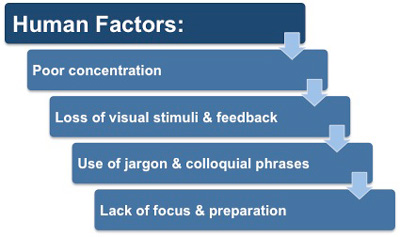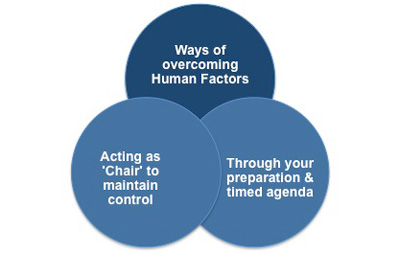Conference Calls and Human Factor Issues
The other aspect that impacts the effectiveness of conference calls is the human element. This mainly relates to how you behave and your attitude during the call. As a manager your main influence on how others treat conference calls is by setting your own example. If you portray and talk of these calls in a positive manner, then others will adopt similar attitudes towards them.
As with all conversations, the behavior of others is greatly influenced by the physical presence of another and how they represent themselves. This does not exist in a teleconference call because each person is in their own environment and not in the formal setting of a meeting. Also, many of the visual indicators that temper how individuals behave together are lacking, such as facial expressions and body language.
 |
The normal behavior parameters everyone adopts in a meeting do not apply as some people will still be at home, others in the office and others will be traveling. So each of these individuals will have distractions related to their location at the time of the call. One of the most common issues your calls will face is participants' loss of concentration.
This can occur at any time during the call and be caused by a local distraction or as a result of the person speaking wandering off topic or communicating their message poorly. It will be more difficult to identify this sort of behavior in a call because you are unable to see the individual's facial expressions or body posture which would let you know they were not paying attention.
You, as the person who requested the call, can minimize this sort of issue by acting in the same way as if you were chairing a meeting. You control and focus the discussions and draw individuals into the discussion as you need, whilst adhering to your own timed schedule (agenda).
One simple way to ensure that all those involved in the call have the opportunity to contribute is to list them all and if appropriate list names against topics. You can then quickly tick off each person as they speak on a topic and call on an individual if they haven't yet contributed despite you feeling that they have something to offer.
 |
Another human factor affecting the outcome of your calls is the language used by yourself and the others on the call. With many of the calls crossing international borders, use of slang expressions and colloquial phrases needs to be avoided; otherwise, the meaning of a contribution could be lost or misinterpreted.
In your role as 'call chair' you must ensure that any references to technical jargon or acronyms are known to all those involved; this is especially important if you are not aware of a caller's background or expertise. You may want to quickly qualify the meaning as part of your introduction to a discussion topic.
When you are involved in these types of calls you must be aware of the language you use and actively listen to feedback, ensuring that the message has been received and understood correctly. It is essential that you ensure that everyone has understood the messages being communicated so that they can fully contribute to each topic.
Preparation is the key to your conference calls being an effective communications tool and minimizing the disruptive aspects of the individuals involved. Before agreeing to attend a meeting you expect to know the length of the event, what it hopes to achieve and what items will be discussed so that you are aware of what you need to prepare to participate fully.
So why should this 'conference call', which is just a meeting using phones or other devices rather than bringing participants to one location, be treated in a less professional or effective way? The answer is, 'it shouldn't be treated any differently. Prior to your call, use the technology to communicate your conference call agenda. This tells everyone involved how long the call last, what will be discussed and the purpose for the call in a clear and concise manner.
By setting the example that all conference calls must have a purpose, a time limit and will be run along similar lines to a meeting you will reduce the number of unnecessary calls. Technology now ensures that you are available 24/7, so the temptation to call someone rather than think through a problem or make your own decision is extremely high.
This unwillingness to make decisions is based on the fear of what will happen if you get it wrong, both from a personal and an organizational perspective. As a manager you need to coach your team to use this technology wisely and effectively so that everyone benefits.
The actions you take after your calls will affect how productive your calls are viewed by others and yourself. As with a meeting you send out minutes, so with a call you communicate, via email or text, the findings and agreements reached during the conversation. This ensures that everyone understands the value of the call and its achievements.
You may also be interested in:An Introduction to Conference Calls, Types of Conference Call, Technical Issues Affecting Conference Calls, Human Factor Issues, Maintaining Your Productivity, Adapting Your Communication Style, Advance Planning, Controlling the Call and Conference Call Etiquette.



